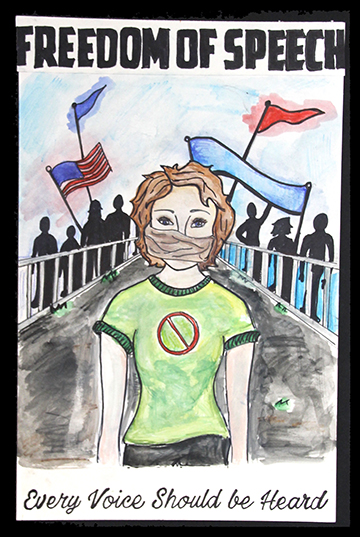High School Art Exhibition Explores The Meaning of Freedom To a New Generation
Stockbridge, MA, March 4, 2016—What does freedom mean in the 21st century? In celebration of the 75th anniversary of President Franklin Delano Roosevelt’s “Four Freedoms” speech, Norman Rockwell Museum is teaming up with New York’s Capital Area Art Supervisors to present a unique exhibition that looks at the concept of the four freedoms, famously painted by artist Norman Rockwell, from the perspective of a new generation. Reimagining The Four Freedoms is on view at the Museum from March 11 through April 3, 2016.
Reimagining The Four Freedoms will display around 75 original artworks, created in a variety of mediums, by Region 6 Capital Eastern District high school students from New York State. Works from students enrolled in Studio in Art classes in Schoharie, Albany, Columbia, Fulton, Greene, Montgomery, Rensselaer, Saratoga, Schenectady, Warren and Washington counties will be on view. Each work will relate to a freedom most important to the individual student.
“The concept behind this was what is the idea of freedom like for these young people, compared to 75 years ago?” notes Sheila Elario, a K-12 instructional administrator for the Guilderland Central School District and member of the Capital Area Art Supervisors group, who organized the exhibition. “Knowing it was different for me, I knew it was different for this age group and I needed to find out what it was. This exhibition was a great way for them to express this, and give them their own voice.”
A special closing reception for the artists and public will be held on Sunday, April 3, from 1 to 3 p.m.
About Capital Area Art Supervisors
The mission of the Capital Area Arts Supervisors is to ensure that all regional K-12 students experience creative and critical thinking for life-long learning through visual arts education as a means to fostering personal growth, community involvement, and social and career development.
About The Four Freedoms
In his January 1941 address to Congress, President Franklin Delano Roosevelt articulated his vision for a postwar world founded on four basic human freedoms: freedom of speech, freedom of religion, freedom from want, and freedom from fear. In the spring of 1942, Norman Rockwell was working on a piece commissioned by the Ordnance Department of the U.S. Army, a painting of a machine gunner in need of ammunition. Posters of the gunner, titled “Let’s Give Him Enough and On Time,” were distributed to ordnance plants throughout the country to encourage production. But Rockwell wanted to do more for the war effort and decided he would illustrate Roosevelt’s four freedoms. Finding new ideas for paintings never came easily, but this was a greater challenge. “It was so darned high-blown,” Rockwell said, “Somehow I just couldn’t get my mind around it.” While mulling it over, Rockwell, by chance, attended a town meeting where one man rose among his neighbors and voiced an unpopular view. That night Rockwell awoke with the realization that he could paint the freedoms best from the perspective of his own hometown experiences using everyday, simple scenes such as his own town meeting. Rockwell made some rough sketches and, accompanied by fellow Post cover artist Mead Schaeffer, went to Washington to propose his poster idea.
The timing was wrong. The Ordnance Department didn’t have the resources for another commission. On his way back to Vermont, Rockwell stopped at Curtis Publishing Company, publisher of The Saturday Evening Post, and showed his sketches to editor Ben Hibbs. Hibbs immediately made plans to use the illustrations in the Post. Rockwell was given permission to interrupt his work for the magazine—typically one cover per month—for three months. But Rockwell “got a bad case of stage fright,” and it was two and a half months before he even began the project. “It was a job that should have been tackled by Michelangelo,” he said in a New Yorker interview three years later.
The paintings were a phenomenal success. After their publication, the Post received 25,000 requests for reprints. In May 1943, representatives from the Post and the U.S. Department of the Treasury announced a joint campaign to sell war bonds and stamps. They would send the Four Freedoms paintings along with 1,000 original cartoons and paintings by other illustrators and original manuscripts from The Saturday Evening Post on a national tour. Traveling to sixteen cities, the exhibition was visited by more than a million people who purchased 133 million dollars in war bonds and stamps. Bonds were sold in denominations of $25, $100, and $1,000, and each person who purchased one received a set of prints of the four paintings. In addition, the Office of War Information printed four million sets of posters of the paintings. Each was printed with the words “Buy War Bonds.” They were distributed in United States schools and institutions, and overseas.


